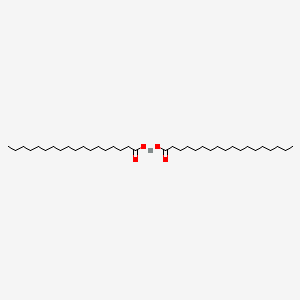



1. Aluminum Monostearate
2. Aluminum Tristearate
3. Ammonium Stearate
4. Calcium Stearate
5. Magnesium Stearate
6. Octadecanoic Acid
7. Sodium Stearate
8. Stearic Acid
1. 557-05-1
2. Zinc Distearate
3. Zinc Octadecanoate
4. Octadecanoic Acid, Zinc Salt
5. Metallac
6. Stearates
7. Zn Stearate
8. Talculin Z
9. Stavinor Zn-e
10. Zinc Bisstearate
11. Metasap 576
12. Zinc Stearate W. S
13. Stearic Acid, Zinc Salt
14. Zinc Stearate [usp]
15. Stearic Acid Zinc Salt
16. H92e6qa4fv
17. Zinc Stearate (usp)
18. Hydense
19. Hytech
20. Mathe
21. Coad
22. Zinci Stearas
23. Zink Distearat
24. Unichem Zs
25. Zincum Stearinicum
26. 144188-98-7
27. Dibasic Zinc Stearate
28. Petrac Zn-41
29. Caswell No. 926
30. Synpro Stearate (van)
31. Witco Zinc Stearate Usp
32. Hsdb 212
33. Nsc-25957
34. Zinc Distearate, Pure
35. Einecs 209-151-9
36. Nsc 25957
37. Zinc Stearate, Total Dust
38. Unii-h92e6qa4fv
39. Epa Pesticide Chemical Code 077002
40. Zincstearate
41. Ai3-00388
42. Znst
43. Zinc;octadecanoate
44. Zinc Stearate, Respirable Fraction
45. Zinc Dioctadecanoate
46. Zinc(ii) Stearate
47. Zinc Stearate Spl
48. Zinc Stearate Tcg
49. Zinc Stearate Tcp
50. Einecs 257-363-5
51. Octadecanoic Acid, Zinc Salt, Basic
52. Octadecanoic Acid, Zinc Salt (2:1)
53. Lubimax Zinc Stearate
54. Rashayan Zinc Stearate
55. Starbld0000624
56. Ec 209-151-9
57. Schembl4923
58. Zinc Stearate [ii]
59. Zinc Stearate [mi]
60. Zinc Stearate [hsdb]
61. Zinc Stearate [inci]
62. Zinc Stearate [vandf]
63. Zinc Stearate [mart.]
64. Zinc Stearate [usp-rs]
65. Zinc Stearate [who-dd]
66. Dtxsid7027209
67. Zinc Stearate, Zno 12.5-14%
68. Mfcd00013031
69. Zinc Stearate [ep Monograph]
70. Zinc Stearate [usp Monograph]
71. Akos015915230
72. 51731-04-5
73. Ft-0645152
74. D06370
75. A830766
76. Q204923
| Molecular Weight | 632.3 g/mol |
|---|---|
| Molecular Formula | C36H70O4Zn |
| Hydrogen Bond Donor Count | 0 |
| Hydrogen Bond Acceptor Count | 4 |
| Rotatable Bond Count | 30 |
| Exact Mass | 630.456552 g/mol |
| Monoisotopic Mass | 630.456552 g/mol |
| Topological Polar Surface Area | 80.3 Ų |
| Heavy Atom Count | 41 |
| Formal Charge | 0 |
| Complexity | 196 |
| Isotope Atom Count | 0 |
| Defined Atom Stereocenter Count | 0 |
| Undefined Atom Stereocenter Count | 0 |
| Defined Bond Stereocenter Count | 0 |
| Undefined Bond Stereocenter Count | 0 |
| Covalently Bonded Unit Count | 3 |
Zinc stearate is a mild antiseptic and astringent, and it has been used as a local soothing application for inflammatory and irritating skin diseases.
Cosmetic Ingredient Expert Review Panel; Final Report on the Safety Assessment of Lithium Stearate, Aluminum Distearate, Aluminum Stearate, Aluminum Tristearate, Ammonium Stearate, Calcium Stearate, Magnesium Stearate, Potassium Stearate, Sodium Stearate and Zinc Stearate. Journal of the American College of Toxicology 1 (2): 143-77 (1982).
Zinc stearate is primarily used in pharmacuetical formulations as a lubricant in tablet and capsule manufacture at concentrations up to 1.5% w/w.
Rowe, R.C., Sheskey, P.J., Quinn, M.E.; (Eds.), Handbook of Pharmaceutical Excipients 6th edition Pharmaceutical Press, London, England 2009, p. 793
In dental cement
Kirk-Othmer Encyclopedia of Chemical Technology. 3rd ed., Volumes 1-26. New York, NY: John Wiley and Sons, 1978-1984., p. 7: 467 (1979)
... Its use as dusting powder for infants is not recommended.
American Hospital Formulary Service. Volumes I and II. Washington, DC: American Society of Hospital Pharmacists, to 1984., p. 84:24
In humans with no excessive intake of zinc, the body burden half-time of absorbed radio-labelled zinc has been observed to range from 162 to 500 days. After parenteral administration of 65Zn2+, half-times ranged from 100 to 500 days. /Zinc ions/
European Chemicals Bureau; Risk Assessment Report on Zinc Distearate, CAS-No.: 557-05-1, 91051-01-3. EINECS-No.: 209-151-9, 293-049-4. Part II - Human Health p.37 (2004). Available from, as of March 24, 2011: https://ecb.jrc.ec.europa.eu/DOCUMENTS/Existing-Chemicals/RISK_ASSESSMENT/REPORT/zincdistearatereport074.pdf
Within certain limits, mammals can maintain the total body zinc and the physiologically required levels of zinc in the various tissues constant, both at low and high dietary zinc intakes. The sites of regulation of zinc metabolism are: absorption of Zn2+ from the gastrointestinal tract, excretion of zinc in urine, exchange of zinc with erythrocytes, release of zinc from tissue, and secretion of zinc into the gastrointestinal tract. Regulation of gastrointestinal absorption and gastrointestinal secretion probably contributes the most to zinc homeostasis. /Zinc ions/
European Chemicals Bureau; Risk Assessment Report on Zinc Distearate, CAS-No.: 557-05-1, 91051-01-3. EINECS-No.: 209-151-9, 293-049-4. Part II - Human Health p.38 (2004). Available from, as of March 24, 2011: https://ecb.jrc.ec.europa.eu/DOCUMENTS/Existing-Chemicals/RISK_ASSESSMENT/REPORT/zincdistearatereport074.pdf
Zinc is mostly bound to organic ligands rather than free in solution as a cation. Zinc is found in diffusible and non-diffusible forms in the blood and about 66% of the diffusible form of zinc in the plasma is freely exchangeable and loosely bound to albumin. A small amount of the non-diffusible form of zinc is tightly bound to 2-macroglobulin in the plasma and is not freely exchangeable with other zinc ligands. Zinc is incorporated into and dissociated from alpha2-macroglobulin only in the liver. /Zinc ions/
European Chemicals Bureau; Risk Assessment Report on Zinc Distearate, CAS-No.: 557-05-1, 91051-01-3. EINECS-No.: 209-151-9, 293-049-4. Part II - Human Health p.36 (2004). Available from, as of March 24, 2011: https://ecb.jrc.ec.europa.eu/DOCUMENTS/Existing-Chemicals/RISK_ASSESSMENT/REPORT/zincdistearatereport074.pdf
For zinc, whole body: 162-500 days; [TDR, p. 1245]
TDR - Ryan RP, Terry CE, Leffingwell SS (eds). Toxicology Desk Reference: The Toxic Exposure and Medical Monitoring Index, 5th Ed. Washington DC: Taylor & Francis, 1999., p. 1245
In humans with no excessive intake of zinc, the body burden half-time of absorbed radio-labelled zinc has been observed to range from 162 to 500 days. After parenteral administration of 65Zn2+, half-times ranged from 100 to 500 days. /Zinc ions/
European Chemicals Bureau; Risk Assessment Report on Zinc Distearate, CAS-No.: 557-05-1, 91051-01-3. EINECS-No.: 209-151-9, 293-049-4. Part II - Human Health p.37 (2004). Available from, as of March 24, 2011: https://ecb.jrc.ec.europa.eu/DOCUMENTS/Existing-Chemicals/RISK_ASSESSMENT/REPORT/zincdistearatereport074.pdf